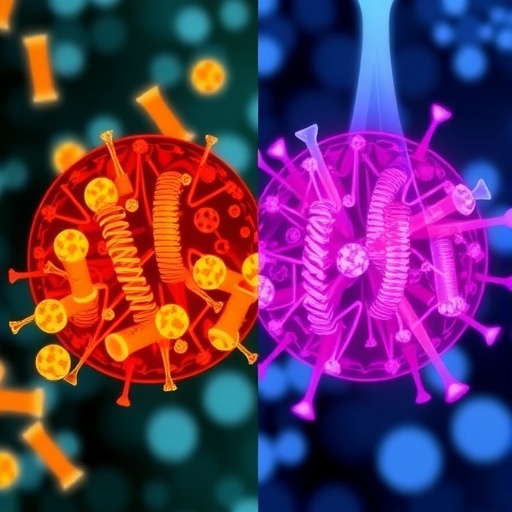Strategies to treat pain without triggering dangerous side effects such as euphoria and addiction have proven elusive. For decades, scientists have attempted to develop drugs that selectively activate one type of opioid receptor to treat pain while not activating another type of opioid receptor linked to addiction. Unfortunately, those compounds can cause a different unwanted effect: hallucinations. But a new study led by Washington University School of Medicine in St. Louis has identified a potential route to pain relief that neither triggers addiction nor activates the pathway that causes hallucinations.

Credit: Che Lab Washington University
Strategies to treat pain without triggering dangerous side effects such as euphoria and addiction have proven elusive. For decades, scientists have attempted to develop drugs that selectively activate one type of opioid receptor to treat pain while not activating another type of opioid receptor linked to addiction. Unfortunately, those compounds can cause a different unwanted effect: hallucinations. But a new study led by Washington University School of Medicine in St. Louis has identified a potential route to pain relief that neither triggers addiction nor activates the pathway that causes hallucinations.
The research is published May 3 in the journal Nature.
Painkilling drugs such as morphine and oxycodone, as well as illegal street drugs such as heroin and fentanyl, activate what are known as mu opioid receptors on nerve cells. Those receptors relieve pain but also cause euphoria — the feeling of being high — and that feeling contributes to addiction. An alternative strategy is to target another opioid receptor, called the kappa opioid receptor. Scientists attempting to make drugs that target only the kappa receptor have found that they also effectively relieve pain, but they can be associated with other side effects such as hallucinations.
Researchers at the Center for Clinical Pharmacology at Washington University School of Medicine and the University of Health Sciences & Pharmacy, also in St. Louis, have identified the potential mechanisms behind such hallucinations, with the goal of developing painkillers without this side effect. Using electron microscopes, they identified the way that a natural compound related to the salvia plant selectively binds only to the kappa receptor but then causes hallucinations.
“Since 2002, scientists have been trying to learn how this small molecule causes hallucinations through kappa receptors,” said principal investigator Tao Che, PhD, an assistant professor of anesthesiology. “We determined how it binds to the receptor and activates potential hallucinogenic pathways, but we also found that other binding sites on the kappa receptor don’t lead to hallucinations.”
Developing new drugs to target these other kappa receptor binding sites may relieve pain without either the addictive problems associated with older opioids or the hallucinations associated with the existing drugs that selectively target the kappa opioid receptor.
Targeting the kappa receptor to block pain without hallucinations would be an important step forward, according to Che, because opioid drugs that interact with the mu opioid receptor have led to the current opioid epidemic, causing more than 100,000 overdose deaths in the U.S. in 2021.
“Opioids, especially synthetic opioids such as fentanyl, have contributed to far too many overdose deaths,” Che said. “There’s no doubt we need safer pain-relieving drugs.”
Che’s team, led by first author Jianming Han, PhD, a postdoctoral research associate in Che’s laboratory, found that a class of signaling proteins called G proteins cause the kappa opioid receptor to activate several different pathways.
“There are seven G proteins linked to the kappa receptor, and although they are very similar to each other, the differences between the proteins may help explain why some compounds can cause side effects such as hallucinations,” Han said. “By learning how each of the proteins binds to the kappa receptor, we expect to find ways to activate that receptor without causing hallucinations.”
The function of the G proteins has largely been unclear until now, particularly the protein that activates the pathway lined to hallucinations.
“All of these proteins are similar to one another, but the specific protein subtypes that bind to the kappa receptor determine which pathways will be activated,” Che said. “We have found that the hallucinogenic drugs can preferentially activate one specific G protein but not other, related G proteins, suggesting that beneficial effects such as pain relief can be separated from side effects such as hallucinations. So we expect it will be possible to find therapeutics that activate the kappa receptor to kill pain without also activating the specific pathway that causes hallucinations.”
Han J, Zhang J, Nazarova AL, Bernhard SM, Krumm BE, Zhao L, Lam JH, Rangari VA, Majumdar S, Nichols DE, Katritch V, Yuan P, Fay JF, Che, T. Ligand and G protein selectivity in kappa opioid receptor. Nature, May 3, 2023.
The study was funded with support from the National Institute of General Medical Sciences and the National Institute of Neurological Disorders and Stroke of the National Institutes of Health (NIH). Grant numbers: R35 GM143061 and R01 NS099341.
About Washington University School of Medicine
WashU Medicine is a global leader in academic medicine, including biomedical research, patient care and educational programs with 2,800 faculty. Its National Institutes of Health (NIH) research funding portfolio is the third largest among U.S. medical schools, has grown 52% in the last six years, and, together with institutional investment, WashU Medicine commits well over $1 billion annually to basic and clinical research innovation and training. Its faculty practice is consistently within the top five in the country, with more than 1,800 faculty physicians practicing at 65 locations and who are also the medical staffs of Barnes-Jewish and St. Louis Children’s hospitals of BJC HealthCare. WashU Medicine has a storied history in MD/PhD training, recently dedicated $100 million to scholarships and curriculum renewal for its medical students, and is home to top-notch training programs in every medical subspecialty as well as physical therapy, occupational therapy, and audiology and communications sciences.
Journal
Nature
Method of Research
Observational study
Subject of Research
Cells
Article Title
Ligand and G protein selectivity in kappa opioid receptor
Article Publication Date
3-May-2023




